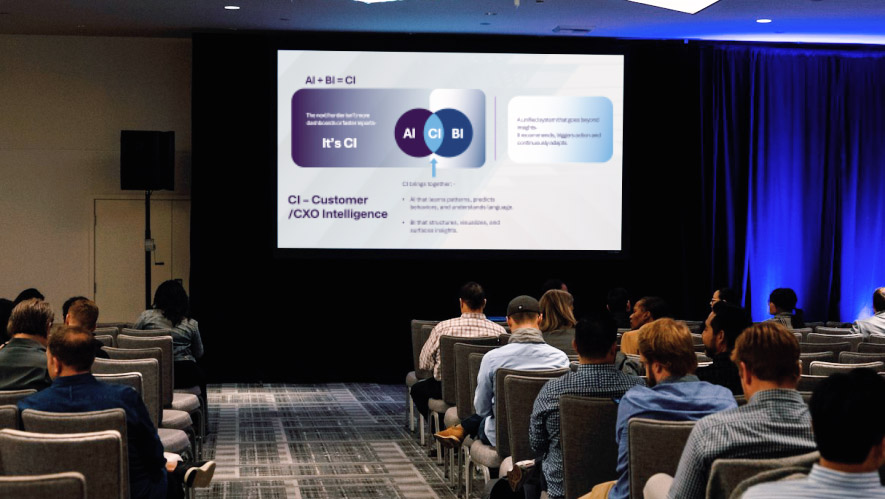We’ve built the tech stack, eg: AI models, BI tools, cloud platforms. On paper, we’re a data-driven powerhouse.
But when real decisions need to be made, we still open Excel.
This isn’t just a minor inconvenience. It reveals something much deeper: a systemic disconnect between intelligence and action.
The ROI Dissonance
We’ve all been there. Your business has invested millions in AI models, BI platforms, cloud infrastructure, and digital dashboards. You’ve hired data scientists, subscribed to premium analytics tools, and proudly showcased automation pilots to the board. And yet, when it’s time for a sales forecast, a pricing review, or to troubleshoot a supply chain bottleneck and someone still exports everything into Excel.
This isn’t a failure of effort. It’s not incompetence or lack of vision. What we’re seeing is fragmentation.
A recent Gartner survey found that 73% of enterprise leaders still rely on Excel for critical decisions, despite having advanced analytics and AI tools available.
The tools are in place. But they don’t speak to each other. Worse as they don’t act together.
You have AI that predicts, dashboards that visualize, and platforms that store but nothing that orchestrates. Each system operates in its own silo, brilliant in isolation, but blind to context.
So what happens? Decision-makers revert to what’s familiar. They cut and paste. They rebuild the story by hand. Not because they want to but just because that’s the only way to make sense of disconnected intelligence.
And that’s the real cost: not just wasted tools, but wasted time. Slower decisions. Lost opportunities. You don’t just need smarter tech. You need connected intelligence, where data flows seamlessly, models talk to each other, and insight translates to action in real time.
Until then, the Excel export will continue to be the unofficial bridge between innovation and execution and that’s not where your ROI should live.
The Agentic Gap: From Intelligence to Impact
Here’s the core problem:
Today’s systems are intelligent. But they’re not agentic.
They analyze, report, and even forecast, but they don’t move. They don’t know when to act.
In a $2B global retail brand, nine forecasting tools produced accurate projections for winter. But because supply chain, merchandising, and marketing ran on siloed systems, all stitched together through spreadsheets, the company still overstocked by 18%. The AI was right. The action didn’t follow.
That’s the gap. Not insight. Not data. Agency.
Until your systems can bridge that insight will remain suggestion, and execution will lag behind need.
Introducing Agentic Systems: The Future of Enterprise Decision-Making
At TMotions, we believe the next stage of digital maturity is agentic intelligence systems that don’t just inform, but act.
Agentic Systems are software constructs that combine AI (to sense and predict), BI (to visualize and contextualize), and automation (to decide and execute) all within human-defined guardrails.
They:
- Recommend and simulate decisions
- Trigger workflows based on thresholds or forecasts
- Continuously adapt based on real-time feedback
This is not AI replacing humans, it’s AI empowering humans by compressing the distance between knowing and doing.
Think of it as moving from “insight to impact” automatically.
A Repeatable Framework: Decision Velocity™
How do we measure progress?
We use a model we call the Decision Velocity Framework™:
Decision Velocity = Data (Breadth) × Insight (Depth) × Action (Speed)
| Element | Description | Weak Point Today |
| Data | Breadth of input sources, from real-time signals to historical logs | Often siloed or delayed |
| Insight | Analytical strength, what patterns and predictions are surfaced | Often static or isolated |
| Action | Ability to translate insight into movement | Often manual or reactive |
The Excel fallback isn’t just about tools. It’s a symptom of low decision velocity.
Reframing the Future: AI + BI = CI (Customer Intelligence)
What if your systems didn’t just observe and predict, but actually helped you move?
The future isn’t more dashboards. It’s about Customer Intelligence (CI) , a seamless integration of AI and BI, focused on what matters most: serving your customer in the moment.
CI = AI (for patterns) + BI (for visibility) → turned into orchestration.
This means:
- A stockout isn’t just shown on a report, it triggers a supply action.
- A sudden spike in demand isn’t just forecasted, it adapts pricing or alerts merchandising.
- A shift in customer behavior doesn’t just show up in a trendline, it nudges the sales team.
We don’t need more insights. We need systems that do something with them.

What’s Missing: Agentic Systems That Know When to Act
Most systems today are smart as they analyze, report, and even predict. But intelligence alone isn’t enough. What’s missing is initiative.
Agentic AI steps into that gap. These are systems that don’t just inform, they act, within clear business-defined boundaries. They recommend next steps, test scenarios, and in some cases, execute actions all while keeping humans in control.
Think of it as moving from insight to impact, automatically:
- A dynamic pricing engine that adjusts rates based on real-time stock and demand fluctuations
- An inventory dashboard that doesn’t just highlight low stock, but triggers a replenishment workflow
- A CRM that doesn’t just flag likely churn, but sends a targeted retention offer before a customer drops off
This is what digital maturity looks like, not just tools that think, but systems that know when to act.
Making It Real: What Enterprise Teams Actually Need
Let’s ground this.
Enterprise teams aren’t looking for more AI vendors or another dashboard interface. They want:
- One source of truth
- Embedded intelligence, not just raw data
- Systems that scale and adapt to real-world complexity
For example, in food commerce (one of TMotions’ verticals), we helped a client unify purchase behavior, inventory forecasts, and supplier reliability data, creating an adaptive system that adjusted procurement cycles weekly, not quarterly. Less waste, more agility, no manual reporting loops.
This didn’t require “more AI.” It just required making the existing pieces talk and move.
TMotions’s Perspective: Quiet Integration, Real Outcomes
At TMotions, we don’t chase buzzwords. We focus on quiet, strategic integration that leads to real operational change.
We help businesses:
- Connect disconnected intelligence
- Build agentic systems around real decision needs
- Scale quiet integration, not noisy disruption
No rip-and-replace. No complexity for the sake of complexity. Just calm, coordinated progress.
From Investment to Movement
You’ve already invested in AI. The components are in place. The capabilities exist. What’s missing isn’t vision, it’s movement.
Your systems don’t need to be smarter. They need to be connected, coordinated, and agentic.
Organizations that unify insight and action won’t just make faster decisions—they’ll shape markets in real time. The next frontier isn’t smarter AI. It’s coordinated, agentic systems that move with your business.
Is your stack ready to lead, without reverting to Excel? Contact us!!













